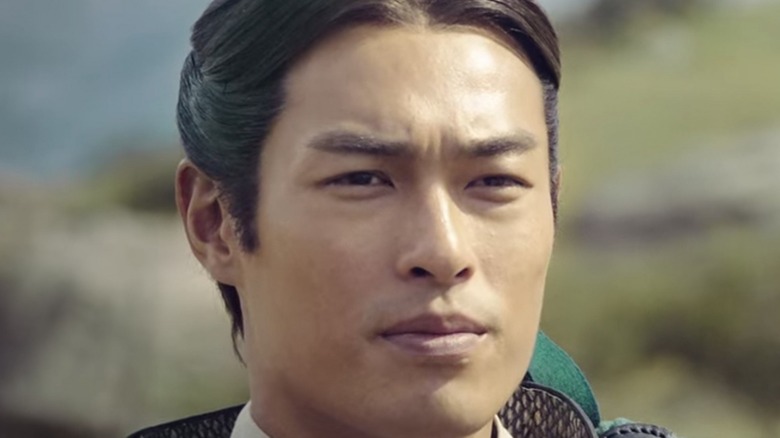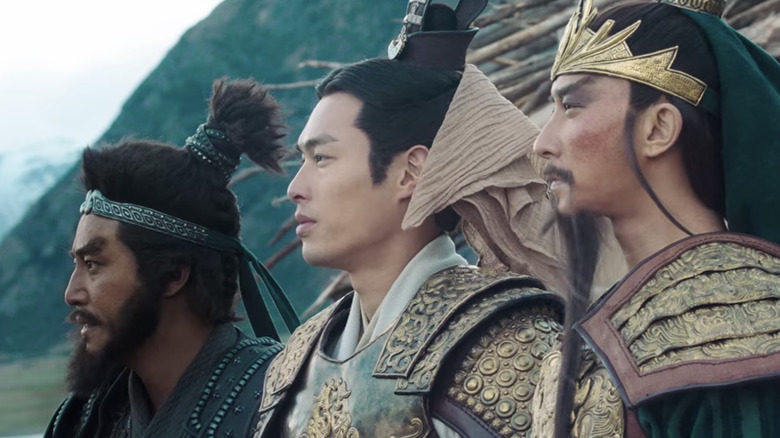The Ending Of Netflix's Dynasty Warriors Explained
Video game movies tend to be hit-or-miss in nature. There have been plenty of flops like 1993's "Super Mario Bros." and 2016's "Assassin's Creed," but there have also been high-grossing video game movies like "Resident Evil: Afterlife." Despite the controversy around them, new video game movies continue to come out each year. One of the most recent releases is Netflix's "Dynasty Warriors," based on the video game franchise of the same name, as well as the classic novel "Romance of the Three Kingdoms."
Set in the late Eastern Han Dynasty, "Dynasty Warriors" tells the story of the Yellow Turban Rebellion, which was a real historical event that was dramatized in "Romance of the Three Kingdoms." When the Yellow Turban Rebellion sets off the end of the Eastern Han Dynasty, three generals named Guan Yu (Han Geng), Liu Bei (Tony Yang), and Zhang Fei (Justin Cheung) band together to defeat the rebel leader Dong Zhuo (Suet Lam) and his own top general, Lu Bu (Louis Koo).
Since "Dynasty Warriors" covers a lot of ground in adapting both the long-running video game franchise and 14th-century tome, it's easy to get lost in the action and miss some key points. To make things a little easier, here's the end of "Dynasty Warriors" explained.
Dynasty Warriors ended with cliffhangers
There technically wasn't a winner at the end of "Dynasty Warriors," though plenty of blood was shed. During the epic battle at Hulao Pass, Guan Yu, Liu Bei, and Zhang Fei take on the powerful Lu Bu together — but he flees before a winner can be determined. However, before leaving, he warns the trio that they aren't done fighting yet, meaning there's plenty of action left for a sequel. General Zhou also flees, and Cao Cao (Kai Wang) reveals his plan to save the dynasty.
The epilogue at the end of "Dynasty Warriors" leaves us with even more unanswered questions. A few years after the battle, Cao visits Guan, Liu, and Zhang at the combat school they've opened. He tells Liu that he intends to restore power to the Han Dynasty and conquer it himself, before riding off to do so, though Liu makes it clear that he's loyal to the Han Court above all. The three allies then exchange a look, seemingly portraying that they're anticipating more fighting to come. Thus, we can likely assume that a sequel is possible as well.
It's loosely based on history
As previously mentioned, "Dynasty Warriors" is based on quite a bit of source material. The inspiration for the source material itself is based on actual historical events that took place in Ancient China. The Yellow Turban Rebellion specifically was a real uprising that, according to Britannica, "contributed to the fall of the Han dynasty." The rebellion served as inspiration for the first few chapters of "Romance of the Three Kingdoms," though the novel added fantasy elements and created several characters for the plot.
Lu Bu was also based on a real historical figure. He was a Chinese military general who lived during the Eastern Han Dynasty and was known for his strength, as depicted in the Netflix anime "Record of Ragnarok." One of the two biographies of Lu Bu is in the historical text "Records of the Three Kingdoms," which also inspired the historical fiction novel "Romance of the Three Kingdoms." Much of Lu Bu's notoriety comes from his portrayal in the popular texts about him, though "Dynasty Warriors" took creative liberties to make him even more amazing.
"Dynasty Warriors" is an action-packed historical fantasy film that requires a strong attention span, but is worth the watch if you're a fan of epic fight sequences and imaginative costuming. You can check it out now on Netflix.


